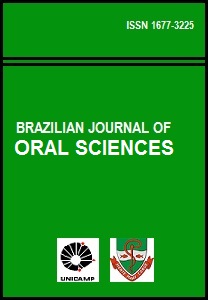Abstract
This study aimed to develop a low cost in vitro viable microbiological model to produce biofilms to be used in dental researches. Single and multi-species biofilms of S. mutans, S. sobrinus, S. mitis, S. salivarius, S. cricetus and S. sanguinis were grown on bovine enamel slabs during 10 days, in a sterile brain-heart infusion broth, containing 5% sucrose and incubated at 37ºC in an atmosphere of 10% CO2 . The slabs were transferred to a fresh medium at every 6, 12 or 24 hours. After the experimental period, enamel volume percent mineral was determined by cross-sectional microhardness. Caries-like lesions were found in all bacterial groups when compared with the control group. No statistical significant differences were found between S. mutans and S. sobrinus with respect of their cariogenicity or among the periods of medium change. However, it was found a statistical significant difference among the cariogenicity of S. salivarius and S. sanguinis (ANOVA followed by Tukey test). This model has successfully developed caries-like lesion on enamel and the medium can be changed at every 24 hours utilizing either S. mutans or S. sobrinus.References
Aldsworth TG, MacFarlane TW. A novel in vitro model system to grow films of oral bacteria for the study of human tooth root surface caries. J Appl Microbiol. 2001; 91: 139-46.
Featherstone JDB, O’Really MM, Shariati M, Brugler S. Enhancement of remineralization in vitro and in vivo. In: Leach SA, editor. Factors relating to demineralization and remineralisation of the teeth. Oxford: IRL Press; 1986. p. 23-34.
Holly FJ, Gray JA. Mechanism for incipient carious lesion growth utilizing a physical model based on diffusion concepts. Arch Oral Biol. 1968; 13: 319-34.
Marsh PD, Nyvad B. The Oral Microflora and Biofilms on Teeth. In: Fejerskov O, Kidd E. Dental caries: the disease and its clinical management. Oxford: Blackwell Munksgaard; 2003. p. 29-48.
Gilbert P, Das J, Foley I. Biofilm susceptibility to antimicrobials. Adv Dent Res. 1997; 11: 160-7.
Katz S, Park KK, Stookey GK, Schemehorn BR. Development and initial testing of a model for in vitro formation of pit and fissure caries. Caries Res. 1986; 20: 424-8.
Tang G, Yip HK, Cutress TW, Samaranayake, LP. Artificial mouth model systems and their contribution to caries research: a review. J Dent. 2003; 31: 161-71.
Gilmour AS, Edmunds DH, Newcombe RG, Clark MF. An in vitro study into the effect of a bacterial artificial caries system on the enamel adjacent to composite and amalgam restorations. Caries Res. 1993; 27: 169-75.
Moller S, Sternberg C, Andersen JB, Christensen BB, Ramos JL, Givskov M, Molin S. In situ gene expression in mixed-culture biofilms: evidence of metabolic interactions between community members. Appl Environ Microbiol. 1998; 64: 721-32.
Loesche WJ. Role of Streptococcus mutans in human dental decay. Microbiol Rev. 1986; 50: 353-80.
Amaechi BT, Higham SM, Edgar WM. Factors affecting the development of carious lesions in bovine teeth in vitro. Arch Oral Biol. 1998; 43: 619-28.
Pantera EA Jr, Schuster GS. Sterilization of extracted human teeth. J Dent Educ. 1990; 54: 283-5.
Parsell DE, Stewart BM, Barker JR, Nick TG, Karns L, Johnson RB. The effect of steam sterilization on the physical properties and perceived cutting characteristics of extracted teeth. J Dent Educ. 1998; 62: 260-3.
Featherstone JD, ten Cate JM, Shariati M, Arends J. Comparison of artificial caries-like lesions by quantitative microradiography and microhardness profiles. Caries Res.1983; 17: 385-91.
Arends J, ten Bosch JJ. Demineralization and remineralization evaluation techniques. J Dent Res. 1992; 71(Spec n.): 924-8.
Shu M, Wong L, Miller JH, Sissons CH. Development of multispecies consortia biofilms of oral bacteria as an enamel and root caries model system. Arch Oral Biol. 2000; 45: 27-40.
Scheie AA, Fejerskov O, Lingstrom P, Birkhed D, Manji F. Use of palladium touch microelectrodes under field conditions for in vivo assessment of dental plaque pH in children. Caries Res. 1992; 26: 44-51.
Marsh PD. The role of microbiology in models of dental caries. Adv Dent Res. 1995; 9: 244-54.
Bowden GHW, Ellwood DC, Hamilton IR. Microbial ecology of the oral cavity. Adv Microb Ecol. 1979; 3: 135-216.
Fontana M, Dunipace AJ, Gregory RL, Noblitt TW, Li Y, Park KK, Stookey GK. An in vitro microbial model for studying secondary caries formation. Caries Res. 1996; 30: 112-8.
Yue SL, Zhou XD, Li J. Multibacterial artificial plaque. A model for studying carious process. Chin Med J. 1992; 105: 25-9.
Gilmour SM, Edmunds DH, Dummer PM. The production of secondary caries-like lesions on cavity walls and the assessment of microleakage using an in vitro microbial caries system. J Oral Rehabil. 1990; 17: 573-8.
Köhler B, Birkhed D, Olsson S. Acid production by human strains of Streptococcus mutans and Streptococcus sobrinus. Caries Res. 1995; 29: 402-6.
Zanin IC, Lobo MM, Rodrigues LK, Pimenta LA, Hofling JF, Goncalves RB. Photosensitization of in vitro biofilms by toluidine blue O combined with a light-emitting diode. Eur J Oral Sci. 2006; 114: 64-9.
Lindquist B, Emilson CG. Interactions between and within Streptococcus mutans and Streptococcus sobrinus isolated from humans harboring both species. Scand J Dent Res. 1991; 99: 498-504.
Hirose H, Hirose K, Isogai E, Miura H, Ueda I. Close association between Streptococcus sobrinus in the saliva of young children and smooth-surface caries increment. Caries Res. 1993; 27: 292- 7.
de Soet JJ, van Loveren C, Lammens AJ, Pavicic MJ, Homburg CH, ten Cate JM et al.. Differences in cariogenicity between fresh isolates of Streptococcus sobrinus and Streptococcus mutans. Caries Res. 1991; 25: 116-22.
Köhler B, Krasse B. Human strains of mutans streptococci show different cariogenic potential in the hamster model. Oral Microbiol Immunol. 1990; 5: 177-80.
Van Houte J, Sansone C, Joshipura K, Kent R. In vitro acidogenic potential and mutans streptococci of human smooth-surface plaque associated with initial caries lesions and sound enamel. J Dent Res. 1991; 70: 1497-502.
de Soet JJ, Nyvad B, Kilian M. Strain-related acid production by oral streptococci. Caries Res. 2000; 34: 486-90.
The Brazilian Journal of Oral Sciences uses the Creative Commons license (CC), thus preserving the integrity of the articles in an open access environment.


